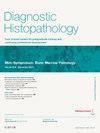Differential diagnosis of sinonasal tumours with emphasis given to undifferentiated malignancy, spindle cell lesions and tumours with divergent differentiation
Abstract
The number and range of tumour types that present in the sinonasal tract is staggering. The most recent WHO classification of head and neck tumours (5th edition) attempts to simplify the issue by focusing on tumours that typically present in this anatomical site (with exclusion of lesions occuring elsewhere in the body). Even then, there are 24 discrete entities described; many of which have sub-variants and well documented histological pitfalls. In this mini-symposium we demonstrate 3 challenging cases from our routine practice that have required consideration of a broad range of entities in the differential diagnosis. The article is laid out in 3 sections covering undifferentiated malignancies, spindle cell lesions and tumours with divergent differentiation respectively. Sinonasal tumours may show considerable histological overlap between entities, and this is illustrated by the fact that many entities described in this article fall into more than one of the categories and some are even present in all three. In each section we recommend a methodical approach with careful consideration of the histological features in combination with appropriate ancillary studies in order to render as accurate a diagnosis as possible.

 求助内容:
求助内容: 应助结果提醒方式:
应助结果提醒方式:


